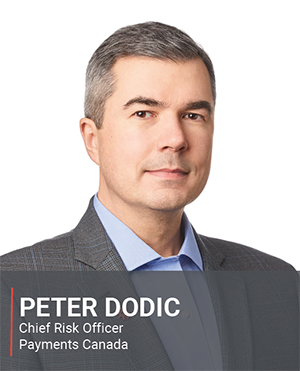Mod Blog: Solving for uncertainty and building more resilient payments systems
In life and business we know that “risk” refers to the uncertainty that surrounds future events and outcomes. Essentially, it’s a measure of the probability of an event and its intended or unintended consequences. Everything we do in life and work has an element of risk – it’s just the degree of severity or likelihood of occurrence that differs. Further, there’s no avoiding the threat of risk, especially from our perspective as a financial market infrastructure. That’s why mitigating for risk is foundational to all that we do at Payments Canada – in particular within payments Modernization.
What risk means from a payments Modernization perspective
When it comes to payments Modernization there are two buckets of risk that take up much of our focus: target state risk and delivery risk. Target state risks are risks that we must be prepared to manage and mitigate when the changes associated with payments Modernization go live. Moreover, identifying target state risks early on in the Modernization journey enables us to design the new processes and systems to effectively mitigate those risks. For example, one of the key needs associated with the Vision for the Canadian payments ecosystem is to have open and risk-based access to the payments systems without compromising security. To be prepared for wider access to the payment systems, we need to design and build from the outset, the right access models and participant requirements to enable competition and innovation, balanced with security and resiliency of the systems. Our proposals and consultations concerning broadening access to Canada’s retail batch payments system, the Automated Clearing and Settlement System (ACSS) and supporting broad financial institution member eligibility to participate directly in Lynx are examples of our efforts to effectively accommodate new entrants and provide for broader, risk-based access to Canada’s payments systems operated by Payments Canada.
Delivery risk is the uncertainty associated with delivering the projects that form the Modernization program on time, on budget and within scope. These would be the risks that are managed on a day-to-day basis, and risks that change as the program progresses along the Modernization Roadmap. These risks range from the risk of losing key personnel who are working on the program – along with knowledge and expertise that they bring to the project – to alignment of all key stakeholders, or the risk of multiple participants not being ready for a system go-live date. Among other things, we are leveraging strong talent management practices, a rigorous project management approach, and our Modernization governance structure to manage and mitigate these risks on an ongoing basis.
How we’re evolving to be prepared for the future
As the payments landscape and ecosystem change, how we approach and manage risks also needs to evolve. There are a few key initiatives that we are undertaking to keep pace and get ahead of these changes in the near term and into the future. Within Enterprise Risk Management, our 2019 focus included identifying and planning out what we need to do over the next few years to ensure we are ready for the changes that are coming with payments Modernization. We’ve also had an independent assessment done of our capabilities, and have developed a clear roadmap to get us to where we need to go.
A key area of focus for Payments Canada is resiliency – resiliency of our processes, systems, and the ecosystem, among other things. In 2020, we are focusing on enhancing our vendor risk management processes as we onboard new vendors to support Modernization and the payments systems. We are also further integrating our business continuity practices to ensure resiliency in a disaster situation, and enhancing our existing risk models, like we did in 2018 with the introduction of a new credit risk model for the country’s retail payments system, to better manage financial risk.
Another important milestone next year is the implementation of the Lynx financial framework and the coordination and support for the execution on the Bank of Canada’s risk prominent payment system (PPS) standards through the Lynx self-assessment process, across the organization.
From our perspective, understanding the risks that we face now and into the future helps us all be better prepared and enables Payments Canada – in collaboration with our members and other stakeholders – to continue to ensure the safety, soundness, and effectiveness of Canada’s payments systems while contributing to the resiliency of the payments ecosystem as a whole.
When it comes to the topic of risk, there is so much to cover. So, keep an eye on this space for insight on how we continue to identify risks and how to mitigate for risks that are not yet known.




